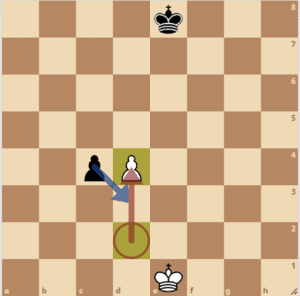In this article I bring to you certain exciting chess tactics that can help you turn the tables. Chess tactics are nothing but short-term measures to change the fate of your game. Let us look at them one by one.
1. En Passant
This is an obscure move that not many novice players are aware of. Generally, pawns can only attack another piece if it’s diagonally in front of them to the left or right. In an En Passant however, a pawn on the 4th rank by attack even if the opposing pawn does a double step.

(When the black pawn is in the 4th rank, the white pawn double stepped to d4. In this situation, the Black player may use En Passant and attack the white pawn as shown in the above diagram)
2. Castling
This is the only move in the game where you can move more than one piece at a time and is generally used to protect the king by exchanging sides with the rook. This move however does have a few restrictions:
- There are no pieces in-between the king and rook.
- Both the king and the castling rook have not yet moved.
- The king is not currently in “check”.
Before Castling:

After Castling:

3. Knight Fork

A knight fork is nothing but a tactic that involves threatening two different pieces of the opponent with your knight. This tactic is powerful because the knight does not move in a straight fashion like the other pieces. Another advantage of employing this tactic is that you can get a more valuable piece like a rook or queen by using the knight.
However, ensure that one of the targets in the fork is not the opponent’s knight, as it will result in you losing your knight. Learn to look for these situations all throughout a game. This could be the one move that shifts the momentum of the game over to your favor.
4. Queen fork

A queen fork is nothing but threatening two different pieces of the opponent with your queen. The queen is the most valuable piece on the board after the King.Hence it is important that you employ the Queen fork with care, as it is not prudent to lose a valuable piece such as the Queen over a lesser valuable piece such as the bishop or knight.
The ideal targets should either be two unprotected pieces or a king and an unprotected piece. Targeting a protected piece will bring about the death of your queen, which can be quite advantageous to your opponent. If employed with care, the queen fork is capable of bringing about a checkmate soon after the exchange.
5. Bishop fork

A bishop fork, as the name suggests, is threatening two different pieces of the opponent using your bishop. This is yet another powerful that can help you gain a piece of the opponent easily. However, ensure that one of the targets is not the opponent’s bishop or queen as it can result in you losing your bishop. Hence employ this tactic with care to yield better results.
6. Rook fork

The rook fork is using the rook to threaten two different pieces of the opponent. Ideally, the rook fork should be used to target two unprotected pieces or the king and an unprotected piece. The rook fork is an effective tactic as the rook is exposed to the entire line. However, ensure that one of the targets in the rook fork is not the opponent’s rook or queen as this can be detrimental to the survival of your rook. Hence employ this tactic with care, as the rook is also a piece of higher value.
7. Arranging a pin
Ideally when an opponent’s piece is threatened, he is met with two options:
- To move the threatened piece (or)
- To bring another piece in between the threatened piece and your piece.
Bringing another piece in between your piece and the threatened piece is referred to as pinning. Though pinning might neutralize the effect of the threat, it comes with a huge disadvantage. The player will not be able to move the pinned piece as long as the threat remains. In other words, the player is rendering a certain piece of his, inactive by the process called pinning.
There are two kinds of pins, namely:
- Absolute pin
- Relative pin
Let us look at these types in detail:
Absolute pin

An absolute pin is the scenario arising out of the following steps:
- You threaten the opponent’s king with a certain piece of yours.
- The opponent positions a certain piece between your piece and his king.
By doing so, the opponent will be forced to keep the pinned piece in place as it will result in an open check. When the threatened piece is the opponent’s king, it is referred to as the absolute pin. Note the example in the above diagram.
The black player’s bishop on f8 must act as an absolute pin in the eighth rank to prevent his king from check by white’s queen. For a better understanding how effective an absolute pin can be, think of what would happen if the white knight on c6 were to position itself onto e7?
Relative pin

A relative pin is similar to the absolute pin in terms of function. However, in the case of a relative pin, the threatened piece is not the opponent’s king. This situation arises out of the following steps:
- You threaten the opponent’s piece of high value such as a queen or rook with a certain piece of yours. (See above example)
- The opponent positions a certain piece between your piece and his valuable piece.
The consequences of a relative pin are similar to that of an absolute pin. Your opponent will be unable to move the pinned piece. However, the magnitude of seriousness is relatively less when compared to the absolute pin as the opponent might decide to sacrifice the threatened piece and move the pinned piece aside.
These are some of the commonly used chess tactics. I am sure that using these tactics wisely will most certainly help you tilt the odds of the game in your favor.






